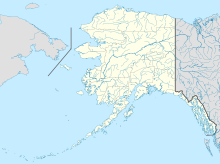Yukon-Kuskokwim Portage
Coordinates: 61 ° 35 ′ N , 160 ° 45 ′ W
The approximately 60 km long land connection between the rivers Yukon and Kuskokwim at the point of their smallest distance from one another is called Yukon-Kuskokwim Portage . The portage is located in the Yukon-Kuskokwim Delta in the eastern part of the Yukon Delta National Wildlife Refuge and connects Russian Mission ( ⊙ ) on the Yukon with Upper Kalskag ( ⊙ ) on the Kuskokwim. The trail has been used by the indigenous people of Alaska since prehistoric times .
The Portage runs mostly through wetlands and waters, first through the Portage Slough on the Yukon, then along the Talbiksok River , through Kulik Lake and finally along Johnson River , Crooked Creek and Mud Creek to the Kuskokwim River.
The Russian Glasunov was probably the first European to use the portage in 1834. In 1842 Lavrenti Sagoskin toured the region on behalf of the Russian-American Company and recommended that the trading post on Kuskokwim be supplied from St. Michael on Norton Sound . The company subsequently transported goods to the Kolmakof Redoubt post upstream from Kalskag via the Yukon-Kuskokwim Portage. After Alaska was bought from Russia in 1898, geologist Josiah Edward Spurr of the United States Geological Survey (USGS) mentioned the increasing economic importance of the waterway to the Yukon. In the course of the construction of the Alaska Railroad , the federal government expanded the portage in order to be able to bring goods from the Kuskokwim region to the new railroad. In 1919 the first detailed map was created by RM Sargent of the USGS. In the 1920s and 1930s, the Alaska Road Commission carried out further extensive expansion work . The use of airplanes made the route less meaningful from the 1940s onwards. After Alaska was recognized as a state in 1959, there were several attempts to restore the overgrown path, none of which were implemented.
Web links
- Yukon-Kuskokwim Portage in the Geographic Names Information System of the United States Geological Survey
